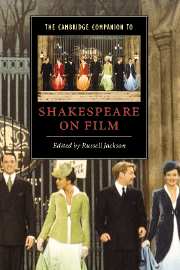Book contents
- Frontmatter
- Introduction
- PART 1 ADAPTATION AND ITS CONTEXTS
- PART 2 GENRES AND PLAYS
- PART 3 DIRECTORS
- PART 4 CRITICAL ISSUES
- 14 Looking at Shakespeare's women on film
- 15 National and racial stereotypes in Shakespeare films
- 16 Shakespeare the illusionist
- 17 Shakespeare's cinematic offshoots
- Further reading
- Filmography
- Index
14 - Looking at Shakespeare's women on film
from PART 4 - CRITICAL ISSUES
Published online by Cambridge University Press: 28 May 2006
- Frontmatter
- Introduction
- PART 1 ADAPTATION AND ITS CONTEXTS
- PART 2 GENRES AND PLAYS
- PART 3 DIRECTORS
- PART 4 CRITICAL ISSUES
- 14 Looking at Shakespeare's women on film
- 15 National and racial stereotypes in Shakespeare films
- 16 Shakespeare the illusionist
- 17 Shakespeare's cinematic offshoots
- Further reading
- Filmography
- Index
Summary
Cinema is a 'looking' medium that writes its texts in visual language, and cinema has always been interested in looking at women. My account of Shakespeare's women on film wants to signal this interest from the beginning by remembering Bogart's 'Here's lookin' at you kid' in Casablanca, not just because that line, which cues the film's repeated instances of lingering focus on Bergman's face, defines a whole genre of cinematic looking, but also because it has achieved epigrammatic status independent of the film. It's become a slogan for much wider cultural habits that may have originated in films like Casablanca but now circulate in culture at large, reproducing cinema's looking practices in real life. The movies, in short, have taught us how to look at each other. To see how cinema has looked at Shakespeare's women, I want to begin with an instance of subversive looking: a wink, the one Mary Pickford's Kate aims sideways out of the frame at the end of The Taming of the Shrew, caught, in the next shot, by her sullen sister Bianca, whom it instantly transforms into a smiling conspirator. That wink rewrites Shakespeare's ending. But more importantly, it inserts into this Shrew a way of looking that is going to signify for the future of Shakespeare's women on film.
- Type
- Chapter
- Information
- The Cambridge Companion to Shakespeare on Film , pp. 241 - 260Publisher: Cambridge University PressPrint publication year: 2000
- 3
- Cited by



